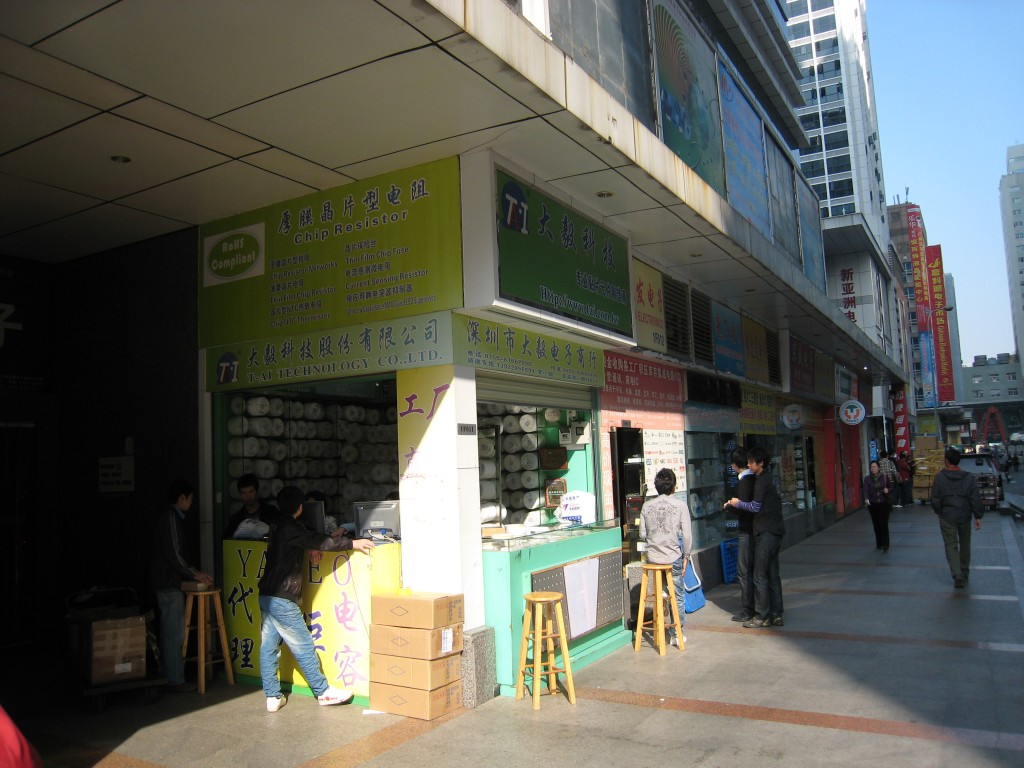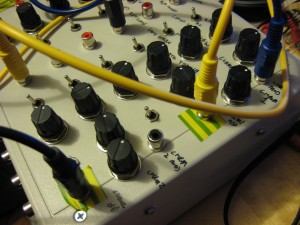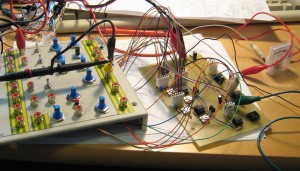Lushprojects Blog
Projects in music, video, art, technology and learning-
Extra bends on GSC AVEP2S
Posted on March 23rd, 2010 No commentsThe circuit-bent AVEP2S is still my favourite video tool. I was looking at some other video circuit benders work and liked a lot of stuff they were doing with chroma keys and control of saturation in an image. This inspired me to go back to the AVEP2S and add a few other nice features.
The first project was to add some simple chroma key functions. The signals that were easily available to do this are the PAL colour components “(R-Y)” and “(B-Y)” so they aren’t real chroma keys because there is a big component of luminance in them too. Still they help slice up the image. The keying circuit is built from a uA733 video amp (from the arc) to boost the signals feeding in to a comparator. I found the 733 amp really hard to work with – it seems very sensitive to DC biasing and impedance on the output. Any advice from readers on how to make effective use of this IC is welcome.
The other mod was to provide an input that can override the manual colour saturation control so that output can be varied dynamically.
With the additional keys you can get some really nice effects – particularly as you can modulate the key with an audio signal.
-
Videobending Utility Functions
Posted on March 22nd, 2010 No commentsI’ve used the spare half of the Down The Bar case to house some utility functions that are useful for getting effects on video bends.
The functions are:
- Two voltage controlled amplifiers based on this design
- Sum/difference amplifier for the output of the two VCAs
- Schmitt trigger with controllable threshold and hysteresis
- Analog meters to show the DC level and AC level of the output from the sum/difference amp
Two 555-based LFOs
With all this to hand the you can create a lot richer effects, and the LFOs allow some “hands free” dynamic effects.
-
Inside a security camera (mostly air)
Posted on March 22nd, 2010 No commentsFor the video bending project I’ve been using a couple of CCD-based security cameras off eBay. They come in nice metal cases and have great performance in low light. The low resolution of the sensor rather spoils the picture quality though, but that’s not much of an issue once you start adding circuit bent mixers.
After a recent gig I noticed that the BNC socket on the back of one of the cameras had been damaged. As I prefer to use phono sockets I decided to take the damaged BNC off and replace it.
So, what’s inside these security cameras? The answer is “mostly air”. There are two little boards at each end and then a long camera body to make it look more substantial.
Just to show how little there is there – here is the whole camera working without its case. Moral of the story – don’t assume that bigger is better!
Another interesting thing I learnt about these cameras is how the iris control on the lens works. It turns out there are only two iris settings – if you set the switch on the back to “indoor” mode then the iris is fully open. If you set it to “outdoor” then the iris is fully closed.
-
MzTEK video on line
Posted on February 8th, 2010 No commentsThe crew at MzTEK have just posted this video about their project to help more women get in to technology. Lots of clips from the Electronics for Absolute Beginners workshop plus a cameo appearance from me.
-
Riverbed Road
Posted on February 5th, 2010 No commentsAttempting to do something gentle with the video circuit bend machinery – here’s Animat’s lovely Riverbed Road with Sharpie TV visuals. Featuring the Sony Family Studio in a supporting role.
Still learning how to make best use of the equipment – just from watching this I see 100 ways to improve!
Edit: Here is all the equipment used to make the above. Hope you like the flowery table cloth.
-
Electronics for Absolute Beginners at MzTEK
Posted on January 24th, 2010 No commentsMy friend Sophie asked me to do a workshop on Electronics for Absolute Beginners for the group MzTEK which ran yesterday. Hard work as a presenter, but I had a really good day. The unflagging enthusiasm and excitement of everybody was great to see and really inspiring. Also lots of fun ideas on different things to do with the circuits in the course. I was also impressed that (almost) everything worked for (almost) everybody. Good building skills all round.
For anybody that wants to see the notes – follow the link above.
-
Visiting the electronics markets at Shenzhen
Posted on January 6th, 2010 No commentsVisiting the electronic markets at Shenzhen is becoming a bit of a geek right of passage. I was fired up to go by reading Bunnie’s Blog and Evil Mad Scientist. When I was in Hong Kong at the end of 2009 I took the chance to hop over the border and see what all the excitement is about. I found this guide useful in getting to the right area. Once there I just explored to my hearts content.
The SEG Plaza seems to be the preferred destination for foreigners. It is pretty impressive starting with little booths selling components on the ground floor and then different types of gadgets on higher floors. However the areas that really blew me away were in other less well marked buildings down the street from SEG or across the other side of the metro station. These buildings are where parts are sourced for manufacturing operations and component factories sell their output. The scale of the whole operation defies believe – there are tens of buildings with huge markets spread over multiple floors and I am guessing I only found a tiny part of the whole thing.

The atmosphere is what a London Victorian street market must have been like. Families and friends man the booths. When not working people are eating, gossiping, flirting, joking and just getting on with life. People pushing hand-carts piled high with “ST Microelectronics” boxes wizz up and down the aisles. Salesmen drop their unused receipts on to the floor and the old bent cleaners shuffle around picking them up. The energy, dynamism and sheer chaos of the place is amazing.
The markets aren’t really set up for casual visitors but as long as you don’t get in people’s way then nobody seems to mind you being there. I saw a few other westerners wandering round in a dazed state so I think the “clueless foreigner come to gawp” is a recognized type. Taking photos is a bit more interesting – people I asked generally said “no”. I suspect perhaps general caution about not wanting to stand-out, but maybe also not everybody has all their paperwork in order. Snapping a few discreet shots should be possible though.

In terms of what you can buy the answer is everything and nothing. Components are really set up to be sold in industrial quantities – unless you want a whole reel then forget it. Test equipment and tools you certainly could buy, but based on my few sample questions I would say the prices are not that much better then you would get on eBay for similar things. Needless to say the whole place is awash with knock-offs, seconds and fakes of all kinds. If you want to buy a set of fake Sony-Ericsson labels to stick on your fake Li-Ion batteries then no problem. I saw one guy lovingly polishing the outside of a dirty old HP spectrum analyser with toothpaste to make it look better before it went on sale. In another stall a couple of guys were pulling surface-mount chips out of a big bag and scrubbing them clean before putting them in individual packaging.
As well as components and manufacturing items you can also buy complete electronics. The PCs and LCD screens were not so exciting, but the vast arrays of fake and real mobile phones are just amazing. The fakes are cheap, but not cheap enough to tempt me to buy. One market had lots of little booths crammed with people working on mobile phone PCBs with surface-mount rework stations. I couldn’t really figure out what service was going on in this place – repair? manufacture? Whatever it was this was painstaking, minute work being done in really cramped conditions.
Visiting the markets is like a glimpse in to some slightly crazed alternate reality in the near future – a Douglas Coupland book made real – I half expected to bump in to Steven Lefkowitz from JPOD around one of the corners. Go there, be amazed but don’t buy anything unless you really know what you’re doing!
-
Exploring the Sony XV-T33F “Family Studio”
Posted on December 29th, 2009 No commentsI saw this beauty on eBay and it looked so good that even without knowing anything I wanted it. It’s a Sony Family Studio XV-T33F which allows text and graphics to be overlaid on to an incoming video. It’s all driven through the touch-pad interface.

When it arrived I rushed to plug it in. All looks good until I start trying to draw – though the smaller buttons work the big touch pad in the middle doesn’t do anything! Disaster! A bit of work with Google and my own observation provides a solution – find the connector to the flexible plastic PCB on the daughter board inside – open and then reconnect this. It seems to be a common problem that this connector fails to make proper contact. My machine was missing screws in the base and it looked like it had been opened before – I wander if the problem is not a new one. Anyway with the connector reseated everything is working. It really is a blast from the past with vivid blocky graphics all based around the Japanese MSX standard.
Now that everything works it’s time to break it again. Andrew Coleman has some really good info on his blog about the architecture and bending possibilities of the XV-T33F. I would only argue with one thing in his comments. He identifies the three main chips on the logic board and explains two of them – the third (labelled Sony LH534HSY) he suggests is the video overlay chip. I’ve looked at this some more and I am convinced it’s not an overlay controller. It appears to be a mask-programmed ROM for the Z80 CPU based on the Sharp LH534B00 IC. The video mixing is done entirely on the second board in the base.

Logic board on Sony XV-T33F
Andrew suggests various bends by shorting-out different pins on the MSX video chip, and they do indeed work very nicely. As an engineer though I was interested to know why this process doesn’t just blow-up the chip. ICs don’t normally like having outputs shorted together. It turns out that the MSX chip (and I assume the RAM too) are based on the NMOS logic family. The interesting property of NMOS for this purpose is that outputs can be pulled to ground by an external component without any damage. Connecting multiple outputs creates a “wire NOR” effect. So I think Andrew’s bends are safe with one exception. NMOS outputs won’t like being pulled up to a hard “VCC” as this will put the transistors under a lot of stress. VCC on the MSC chip is on pin 58 which is one of the pins Andrew suggests using for bending. I haven’t tried myself (and nor do I plan to), but if you care about your MSX IC I wouldn’t try connecting this pin to any of the outputs.

Main boards on Sony XV-T33F
The video mixing board on the XV-T33F isn’t very easy to understand. There are a lot of different video processing chips and lots of TTL analog switches that route things in different directions. It appears to operate in different modes depending on whether the input is composite or S-video (the XV-T33F doesn’t generate S-video output if it only has composite input). There are a number of buttons and one switch on the board which I assume are there as part of the manufacturing testing process. Pressing the buttons produces various interesting distortions, but it often also breaks the sync in the video signal. I am not sure I will be using that as a bend.
One thing that is interesting is trying to work out the signals on the connectors between the two boards. There are two 10 way connectors that are labelled “CN4” and “CN5” on the logic board. Pin numbering is shown on the video mixing board. Here is my assessment of the functions:
Connector CN4:
1: Ground
2: Red video from logic board
3: Ground
4: Dunno
5: Dunno
6: Dunno
7: Overlay on/off – Low = logic board output, High = Video
8: Some kind of HSYNC I think
9: Dunno
10: DunnoConnector CN5:
1: Ground
2: Dunno
3: Dunno
4: Power
5: Power
6: Power
7: Ground
8: Blue video from logic board
9: Ground
10: Green video from logic boardThis information provides some interesting bending possibilities. I plan to cut the R/G/B video signals and the overlay signal to allow these to be modified or processed as they go through.
-
Circuit Bending with ASMO at South Hill Park
Posted on November 30th, 2009 No commentsI went along to the last afternoon of Stu “ASMO” Smith’s circuit bending workshop at South Hill Park in Bracknell on Sunday. Everybody was busy building sequenced APCs like mad. I came along and did some video bending along with their output.
-
Video circuit bending
Posted on November 22nd, 2009 No commentsA post for the RSS followers – up on the main site is a new page for my circuit bent video mixers – including a new YouTube video for the latest completed project.









